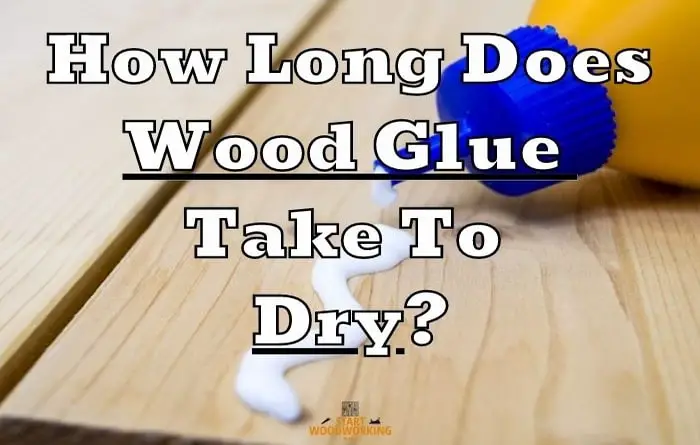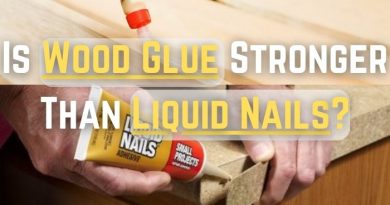How Long Does Wood Glue Take To Dry? (Quick Answer Here)
Wood glue has become an important material for many applications in the building and construction industry. It is a useful adhesive that offers a variety of benefits, such as strong adhesion and flexible application. However, one of its most important qualities is its drying time, which affects how quickly a project can be completed. This article will explore how long wood glue takes to dry, as well as the factors that influence this process.
The drying time of wood glue depends on several key factors. These include the type of wood glue used, environmental conditions, and the amount applied. Different types of wood glues have different drying times depending on their composition.
The environment in which the glue is applied also plays an important role in determining how long it takes to dry; humidity and temperature are two key variables that affect drying time. Finally, when applying wood glue, it is important to consider the amount used; too little or too much will result in a longer drying time than expected.
Understanding how long wood glue takes to dry can help users make informed decisions when working with this adhesive material. The article aims to provide readers with an overview of the factors that influence drying time so they can select the best option for their projects.
Types of Wood glue with Drying and Curing times
1.PVA Glue: PVA (polyvinyl acetate) glue is a popular type of wood glue that dries in around 30 minutes to 1 hour, depending on factors like the thickness of the glue layer and the surrounding conditions. However, it may take up to 24 hours to fully cure and reach maximum strength.
2.Hide Glue: A time-honored kind of wood glue that has been applied for millennia, hide glue is made from animal collagen. Hide Glue cures in 24 hours and dries rapidly, typically in 30 to 1 hour.
3.Epoxy: Epoxy adhesive needs to be mixed before use because it is made up of two parts: a resin and a hardener.
4.Cyanoacrylate (CA) Glue: CA glue, commonly known as super glue, is a fast-drying adhesive that dries in seconds and cures within 24 hours. When it comes to the bond strength, CA glue has one of the lower one and is not suitable for heavy-duty applications.
5.Polyurethane Glue: Polyurethane glue has a longer drying time than other types of glue, taking up to 24 hours or more to dry completely. However, it has a high bond strength and can bond a wide range of materials, including wood, metal, and plastic.
Factors Influencing Wood Glue Drying Times
The amount of time a wood glue takes to dry can vary depending on several factors. One factor is the type of glue used. Different types of wood glues may have different drying times, so it’s important to read the manufacturer’s instructions before use.
Another factor that affects drying time is temperature; generally, higher temperatures will cause wood glue to dry faster than lower temperatures. Additionally, humidity levels can also affect drying time; high humidity levels can cause wood glue to take longer to dry than in low-humidity environments.
Finally, clamping pressure and surface texture are two other factors that can affect how long it takes for a wood glue to dry; tighter clamping pressure and rougher surface textures often increase the amount of time needed for the glue to set fully.
Several things need to be taken into account when determining how long a wood glue will take to dry:
- 1. Types of Wood Glue Used
- 2. Temperature Effects
- 3. Humidity Levels
- 4. Clamping Pressure and Surface Texture
It is important for users to consider all these factors prior to using any type of wood glue in order to ensure successful results and avoid any potential problems down the line.
| Type of Wood Glue | Drying Time | Full Cure Time |
|---|---|---|
| PVA (White Glue) | 30 minutes | 24 hours |
| Polyurethane | 4-24 hours | 24-48 hours |
| Hide Glue | 1-4 hours | 24 hours |
| Cyanoacrylate | 10-20 seconds (initial set) | 24 hours (full cure) |
| Epoxy | 5-10 minutes | 24-72 hours |
Note: Drying time may vary depending on temperature, humidity, and the type and thickness of wood being glued. Full cure time refers to the time it takes for the glue to reach maximum strength and durability.
How Long Does Wood Glue Take To Dry based on Temperature and Humidity
| Type of Wood Glue | Drying Time (70°F, 50% RH) | Drying Time (Higher Temp/Lower Humidity) | Drying Time (Lower Temp/Higher Humidity) | Full Cure Time (70°F, 50% RH) | Full Cure Time (Higher Temp/Lower Humidity) | Full Cure Time (Lower Temp/Higher Humidity) |
|---|---|---|---|---|---|---|
| PVA (White Glue) | 30 minutes | Shorter | Longer | 24 hours | Shorter | Longer |
| Polyurethane | 4-24 hours | Shorter | Longer | 24-48 hours | Shorter | Longer |
| Hide Glue | 1-4 hours | Shorter | Longer | 24 hours | Shorter | Longer |
| Cyanoacrylate | 10-20 seconds (initial set) | Shorter | Longer | 24 hours (full cure) | Shorter | Longer |
| Epoxy | 5-10 minutes | Shorter | Longer | 24-72 hours | Shorter | Longer |
How wood glue drying time can vary depending on environmental factors
The drying time of wood glue can be influenced by a variety of environmental factors, with temperature and humidity being the most significant. Generally speaking, higher temperatures and lower humidity can accelerate the drying process, while lower temperatures and higher humidity can slow it down.
Temperature plays a critical role in the drying process as it directly affects the rate of evaporation of water or solvents in the glue. The higher the temperature, the faster the glue will dry.
However, if the temperature is too high, it can cause the glue to dry too quickly, leading to poor adhesion or a brittle bond. On the other hand, lower temperatures can slow down the drying process, especially for water-based glues that rely on evaporation for drying.
Humidity can also affect the drying time of wood glue as it influences the rate of moisture absorption or loss. Higher humidity can slow down the drying process as it reduces the rate of moisture evaporation from the glue. Conversely, lower humidity can speed up the drying process as it promotes faster moisture evaporation.
It is important to note that the drying time can vary significantly depending on the specific type of glue and the environmental conditions.
How to Speed up the Drying Time for Wood Glue
There are several techniques you can use to speed up the drying time of wood glue.
Here are a few tips to consider:
- Increase Temperature: As mentioned earlier, increasing the temperature can speed up the drying process. However, it is important to stay within the recommended temperature range for the glue being used to avoid causing any damage.
- Decrease Humidity: Lower humidity can help speed up the drying time by promoting faster moisture evaporation from the glue. You can use a dehumidifier or air conditioning unit to reduce humidity in the work area.
- Use Thinner Layers: Applying thinner layers of glue can help speed up drying time as it reduces the amount of moisture that needs to evaporate. It is better to apply several thin layers than one thick layer.
- Use a Fan: A fan can help to circulate air and promote faster moisture evaporation. It is essential to make sure that the fan is not blowing directly on the glue as it can cause the glue to dry unevenly.
- Use Accelerators: Certain types of wood glue accelerators are available in the market that can significantly speed up the drying process. However, it is essential to follow the manufacturer’s instructions carefully while using accelerators.
- Use Heat: Using a heat gun or hair dryer on low heat setting can help to speed up the drying process. However, it is crucial to be cautious while using heat as excessive heat can cause the glue to dry too quickly and become brittle.
How to Make Wood Glue Dry Faster
1.Use a thinner layer of glue
One way to speed up the drying time of wood glue is to apply a thinner layer of glue. A thick layer of glue takes longer to dry because it has more solvent or water to evaporate. A thin layer of glue dries more quickly and can still provide a strong bond. Use a small brush or roller to apply a thin, even layer of glue to the surface.
2.Increase temperature and reduce humidity
The drying time of wood glue can be greatly impacted by temperature and humidity. The glue will cure more quickly in warm, dry environments. To increase the temperature of the workspace where you’re working, use a heater. To avoid the glue drying too rapidly and potentially weakening the bond, keep the heater or hairdryer away from it. Similar to this, lowering the humidity can quicken the drying process. The humidity levels can be lowered with the aid of an air conditioner or dryer.
3.Use a fan
Using a fan to circulate the air can also help to speed up the drying time of wood glue. A fan can help to increase airflow around the glue, which can help the solvent or water to evaporate more quickly. Place the fan a few feet away from the glued surface and direct the airflow towards the surface.
4.Choose a fast-drying glue
Various types of wood glue dry at different pace. For instance, cyanoacrylate glue, also referred to as super glue, dries rapidly and can form a strong bond. However, it has a weaker bond than other types of wood glue and might not be suitable for heavy-duty purposes. Polyurethane glue provides a strong bond and can join a variety of materials, including plastic, metal, and wood, despite the fact that it takes longer to cure.
5.Apply heat
Heat application can also accelerate the drying process of wood glue. To add heat to the glued surface, you can use a heat gun or a soldering iron. Avoid applying too much heat, though, as this can cause the timber to warp or crack.
Accelerating The Drying Process
Expediting the drying process of wood glue is possible with a few methods. Like a spark to kindling, these techniques can ignite the curing process of wood glue.
To begin, utilizing a heat gun will help to evaporate the liquid component of wood glue quickly. Heat guns emit hot air over an area and can be used at low or high temperatures depending on the desired result. However, caution should be taken when using a heat gun as it can cause warping and discoloration.
Additionally, sanding down the area after gluing with fine-grit sandpaper can help to increase surface area for faster drying. This allows more air to flow around the surface and increases the rate of evaporation.
Furthermore, directing a fan at the glued area helps, too; however, it is important to note that increasing fan speed will not necessarily accelerate drying time since there is only so much air that can reach the surface.
Lastly, adjusting acetone concentration and amount of UV light exposure are two other techniques that could potentially reduce drying times, but both require testing in order to gain an understanding of their effects on wood glue’s curing process.
To sum up, there are several ways to expedite wood glue’s curing process, such as using a heat gun, sanding with fine-grit sandpaper, increasing fan speed, adjusting acetone concentration, and exposing glued surfaces to UV light.
Troubleshooting Tips
If wood glue is not drying as expected, there are a variety of troubleshooting techniques one can utilize to tackle adhesive problems. The table below outlines the most common wood glue issues and their respective solutions.
| Issue | Solution |
|---|---|
| Sticky residue left behind after application | Remove the sticky residue by applying a small amount of acetone-free nail polish remover and gently rubbing with a cloth. Rinse the area with warm water to remove any remaining residue. |
| Wood glue not drying or drying too slowly | Allow more time for the glue to dry; some types of wood glue can take up to 24 hours for full curing. To minimize clumping, use an old brush or other applicators to spread the wood glue evenly across the surface before it dries. |
| Wood glue separating from surfaces | Ensure that both surfaces are clean, dry, and free of dust and debris before gluing them together. Apply additional pressure when clamping two pieces together to ensure sufficient contact between them. If necessary, reapply a thin layer of wood glue once it has dried completely. |
By understanding these tips and following best practices when using wood glue, one can expect successful results in bonding various materials together securely. Learning how to address adhesive problems quickly will help prevent costly mistakes or delays in projects requiring wood glue.
How to Apply Wood Glue to Wood
The application of wood glue is an important step in ensuring a strong bond between two pieces of wood. It is important to take the time to properly apply the glue, as not all gluing techniques are equal.
The most common method for applying wood glue is to spread it onto one of the surfaces, then use a brush or roller to spread it evenly across the surface. This will ensure that there is an even layer of glue and will help prevent any air bubbles from forming.
Additionally, it is important to use multiple layers when gluing wood together; this will help create a stronger bond between the pieces. A minimum of three layers should be used, and each layer should be allowed to dry before adding another layer.
Once all layers have been applied, it is recommended that pressure be applied for at least 20 minutes to ensure maximum adhesion. Taking the time to apply wood glue properly can greatly increase its strength and longevity, allowing for a much stronger bond between two pieces of wood.
Common Asked Questions
How long should wood glue dry before removing clamps?
Several variables, including the type of wood glue applied, how much adhesive is applied, the ambient temperature, and humidity, affect how long wood glue needs to dry before clamps can be removed.
As a general guideline, most wood glues need at least 30 to 60 minutes of clamp time in order to set and forge a solid bond between the wood pieces. However, it is advised to leave the clamps in place for a longer period of time—typically around 24 hours—to make sure the glue has completely cured and reached its strongest point.
How long for wood glue to dry before sanding?
The quantity of glue applied, the type of glue used, the atmospheric temperature, and humidity are just a few of the variables that affect how long wood glue needs to cure before sanding.
Generally speaking, wood glues need at least 24 hours to completely dry and solidify before being sanded. This is due to the possibility of a rough or uneven surface if the adhesive is sanded before it has completely dried and gums up the sandpaper.
To prevent harming the wood’s surface, the glue must also be fully dry and fixed before sanding. If you want to know if the adhesive is set enough to sand, carefully push your fingertip into the glue line and look for any indentations.
How long does it take gorilla wood glue to dry?
The manufacturer’s instructions state that Gorilla Wood Glue needs to clamp for 20 to 30 minutes and dry for 24 hours before the glued item can be handled. It’s crucial to remember that drying times can differ based on environmental factors.
How long should wood glue dry before cutting?
Prior to cutting or trimming the wood, it is advised to wait at least 24 hours after applying the glue. This enables the glue to finish drying and develop its complete strength. Cutting the wood too quickly could weaken the connection and lead to glue failure, which would result in the wood pieces separating.
Conclusion
The drying time for wood glue will vary depending on factors such as temperature, humidity, and the type of adhesive being used. Generally speaking, it can take anywhere from one hour to several days for wood glue to dry completely.
Wood glue has been used for centuries to join wood together and is an essential tool in many DIY projects. It is relatively easy to use and, when applied correctly, can provide a strong bond that will last for years.
The irony lies in the fact that although wood glue may seem like a straightforward product and process, there are actually several details that must be taken into account before it can be used effectively and safely. By taking the time to understand these factors, woodworkers can ensure they use the right type of glue for their project and achieve a strong bond that lasts for years to come.
Finally, it is important to know how long your chosen type of glue will take to dry, as this will determine how quickly you can proceed with the project.




